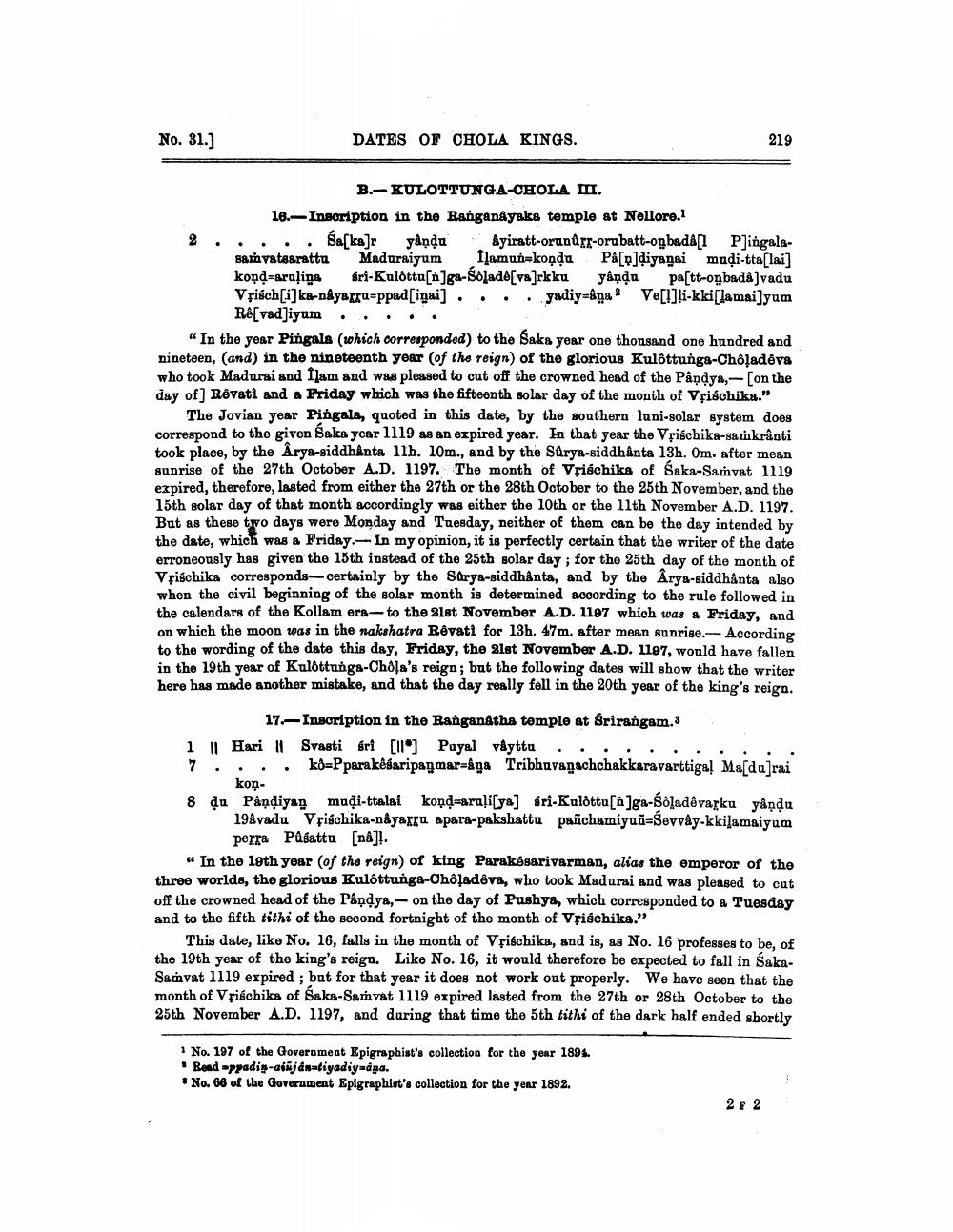________________
No. 31.]
DATES OF CHOLA KINGS.
219
B.- KULOTTUNGA-CHOLA III. 16.--Inscription in the Ranganayaka temple at Nollore. 2 ..... sa[ka]r yandu Syiratt-orunllrr-orubatt-ogbada P]ingala
samvatsarattu Maduraiyum flamun=koņdu PA[p]diyagai muļi-tta[lai] koņd=araļiņa Sri-Kulotto[n]ga-solade[va]rkku yaņda pa[tt-oņbadâ]vadu Vpisch[i]ka-nayaptu=ppad[inai) ....yadiy=&ņas Ve[!]li-kki lamai]yum
Re[vaddiyum ..... "In the year Pingala (which corresponded) to the Saka year one thousand one hundred and nineteen, (and) in the nineteenth year (of the reign) of the glorious Kulôttungs-Chôļadēva who took Madurai and Ilam and was pleased to cut off the crowned head of the Pandya,- (on the day of Revati and a Friday which was the fifteenth solar day of the month of Vrischika."
The Jovian year Pingala, quoted in this date, by the southern luni-solar system does correspond to the given Saka year 1119 as an expired year. In that year the Vțiśchika-sankranti took place, by the Arya-siddhanta llh. 10m., and by the Surya-siddhanta 13h. Om. after mean sunrise of the 27th October A.D. 1197. The month of Vfischika of Saka-Samvat 1119 expired, therefore, lasted from either the 27th or the 28th October to the 25th November, and the 15th solar day of that month accordingly was either the 10th or the 11th November A.D. 1197. But as these two days were Monday and Tuesday, neither of them can be the day intended by the date, which was a Friday. In my opinion, it is perfectly certain that the writer of the date erroneously has given the 15th instead of the 25th solar day, for the 25th day of the month of Vrischika corresponds- certainly by the Sarys-siddhanta, and by the Arya-siddhanta also when the civil beginning of the solar month is determined according to the rule followed in the calendars of the Kollam era- to the 21st November A.D. 1197 which was a Friday, and on which the moon was in the nakshatra Rêvati for 13h. 47m. after mean sunrise. According to the wording of the date this day, Friday, the 21st November A.D. 1197, would have fallen in the 19th year of Kulottunga-Chola's reign; but the following dates will show that the writer here has made another mistake, and that the day really fell in the 20th year of the king's reign.
17.-Insoription in the Ranganatha temple at Srirangam.3 1 || Hari | Svasti sri [11] Payal vậyttu . 7. ... k8=Pparakesaripaņmar=åga Tribhavanachchakkaravarttiga! Ma[du]rai
kon.
8 du Pandiyan mudi-ttalai koņd=araļi[ya] Sri-Kulottu[á]ga-Sôladêvarku yandu
19&vadu Vrischika-n&yatru apara-pakshattu pañchamiyuž=Sevvåy-kkilamaiyum
perra Pagatta [na]!.
In the 19th year of the reign) of king Parakesarivarman, alias the emperor of the three worlds, the glorious Kulôttunga-Chôľadêve, who took Madurai and was pleased to cut off the crowned head of the Påņdya, - on the day of Pushya, which corresponded to a Tuesday and to the fifth tithi of the second fortnight of the month of Vfischika."
This date, like No. 16, falls in the month of Vrischika, and is, as No. 16 professes to be, of the 19th year of the king's reign. Like No. 16, it would therefore be expected to fall in SakaSamvat 1119 expired; but for that year it does not work out properly. We have seen that the month of Vrischika of Saka-Samvat 1119 expired lasted from the 27th or 28th October to the 25th November A.D. 1197, and during that time the 5th tithi of the dark half ended shortly
No. 197 of the Government Epigraphist's collection for the year 1896. • Rend ppadiy-ajájásatiyadiyada. • No. 66 of the Government Epigraphist's collection for the year 1892.
22




